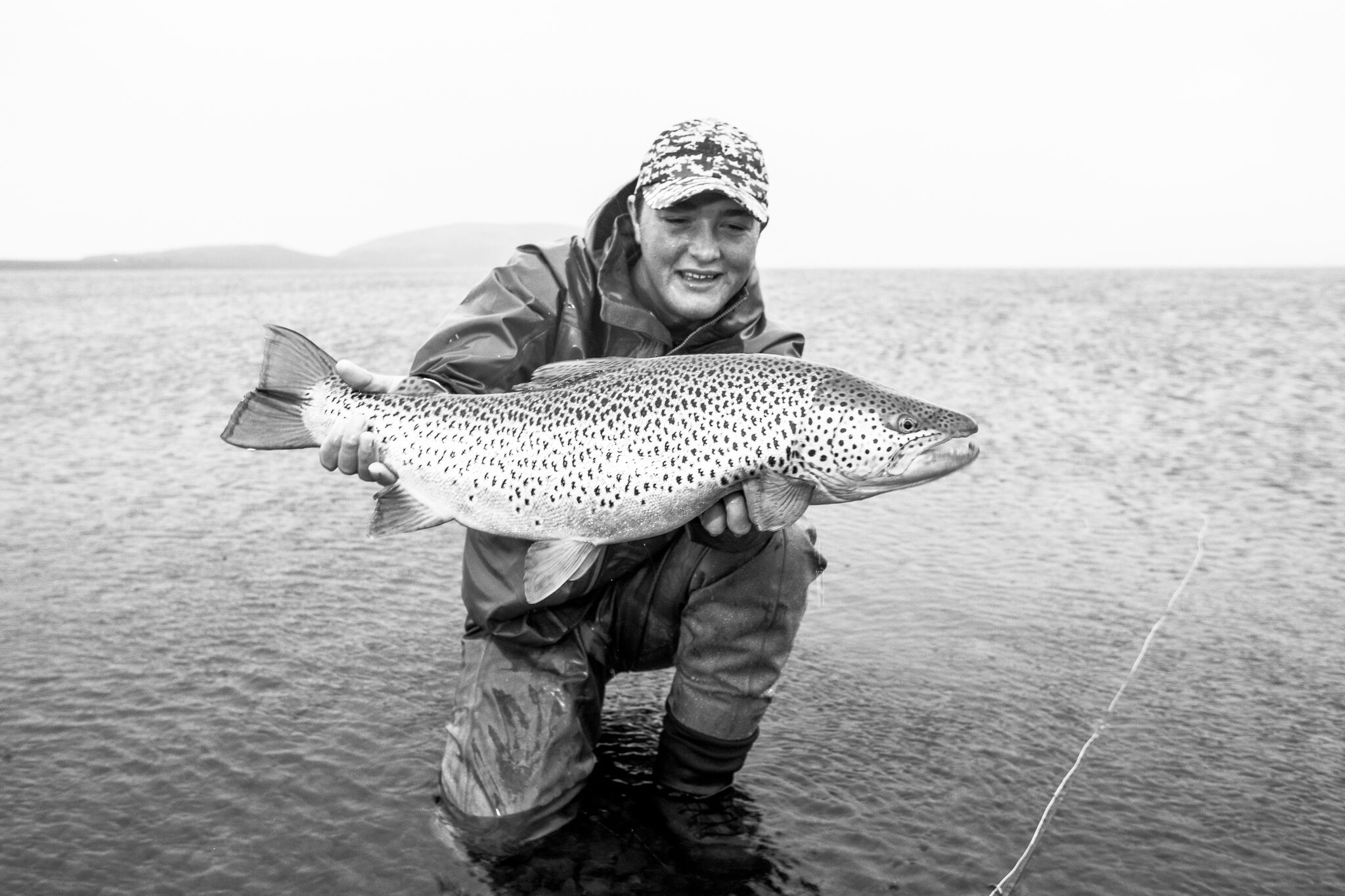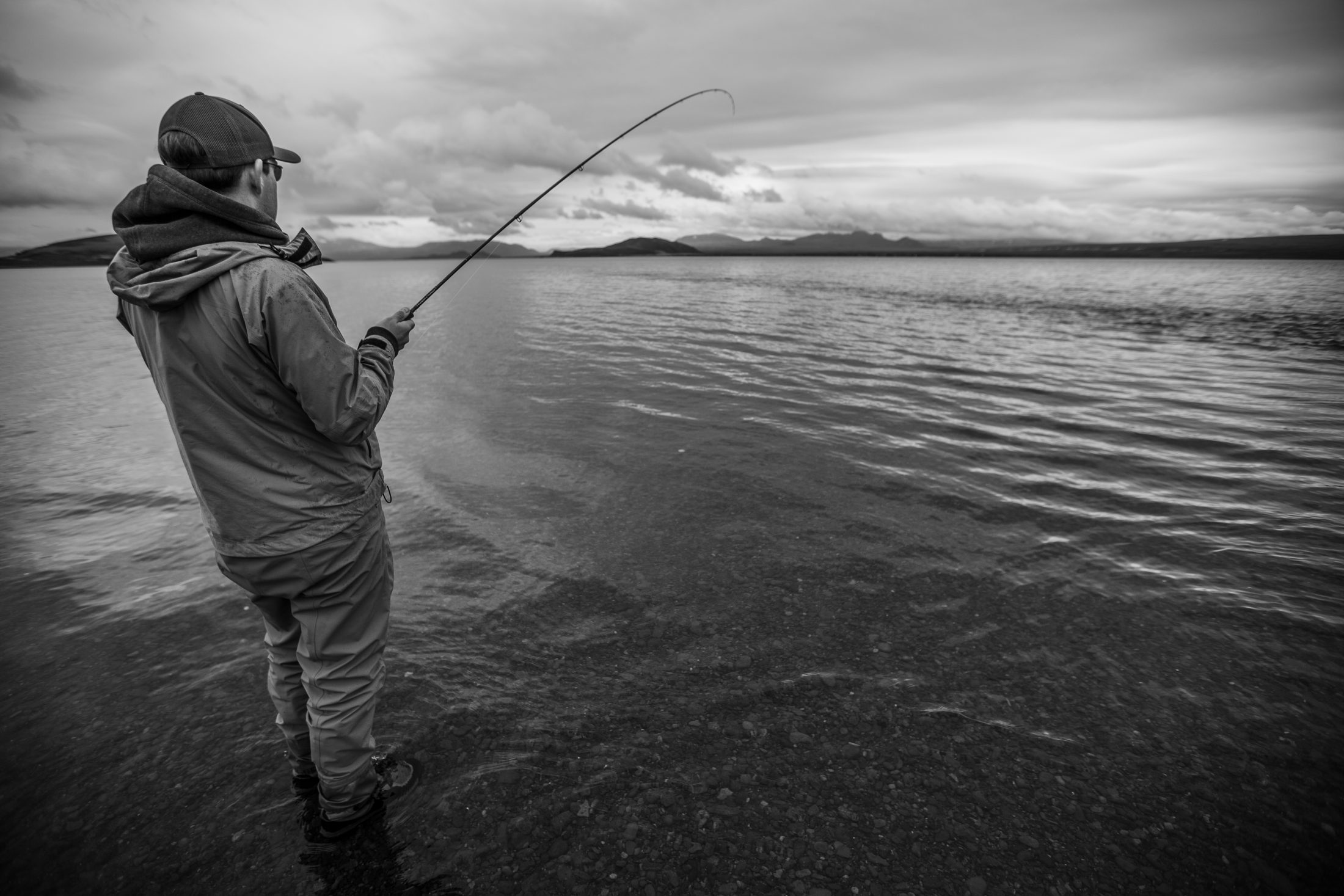Iceland is a wonderful destination for so many reasons, one of my absolute favourites. Due to its northern location on the earth, it has very extreme seasons. The spring is my favourite time of year in Iceland – a rapid blossom of colour and light, long warm evenings and landscape filled with life. Due to the spring being so short everything happens at once. Meadows filled with blooming flora and thousands of ground nesting birds hatching all at once, arctic foxes working hard to feed their young, epic runs of wild salmon trying to reach their spawning grounds and of course huge hatches on the rivers that provides manic feed grounds for the hungry trout that have just spent a winter under the ice.

There are many amazing trout fishing locations all across Iceland, some amazing highland lakes, beautifully clean glacial rivers all imbedded in the stunning game of thrones like scenery of wild Iceland. I am however, going to talk about one location in particular. A wild lake in the west of Iceland.

This adventure for us brits starts in London – a 1 o’clock departure from Heathrow landed us briskly in Keflavik International at ten past three, an hour’s drive to the hotel and we had arrived. The hotel is something to behold in itself. Set in the side of a mountain with a very James Bond like feel to it, its comfort and hospitality is excellent, and it offers some really dramatic views over the hot spring filled mountains. The hot springs make for a very volcanic feeling, everything is bubbling away and looks like it could blow at any minute. Of course, that is not the case. It couldn’t be safer.

After a quick check-in to the hotel, a quick team meeting – on who would be fishing were, a burger to keep the energy levels up and we were off to the beat.
The Lake itself has an area of 84 km2 and a maximum depth of 114m (374ft), to give you an idea Loch Ness has an area of 56.3 km2. This is not a small piece of water. You would think chancing across a brown trout in all this water would be unlikely, even if it is 30lbs, and so it would be, if it wasn’t for an amazing set of coincidences.

As the legend goes, these trout were originally sea trout running a river into the lake until a volcano erupted for a fifth time 2000 years ago. This land locked the sea trout and formed the amazing fishery that a lucky few know today. After years of netting on lake the trout were pushed to the brink of extinction before scientists managed to intervene just in time. After heavy practice in catch and release and the lack of nets the trout have bounced back into action with great success.

These trout do not give a fly fisherman much of an opportunity to strike – these fish spend their days feeding at approximately 30 ft deep on arctic char. This is of course being one of the reasons they grow to such enormous sizes. However, after feeding, each of the trout cruise to certain spots on the lake’s shoreline to warmer water, where there are geothermal springs pumping hot water directly into the lake. We believe they congregate in these spots to increase their body temperature allowing their metabolic process to speed up, before feeding again. It is at this point; we as fly fishermen can ambush.
We cruise the beaches of the lake looking for these hot outlets of water. On a still day they are easy to find, the mirror like effect on the water allows us to see great swarms of fish gathering by the hot water.

We found two main spots on the lake that produce a warm inflow of water. A river and a hot spring. The first evening we arrived at the River beat. Quite a sharp north west wind blew straight into the bay, this is good and bad. Bad in that it’s head-on and rather cold. Good in that it blows the warm water coming from the river right into the beach, therefore keeping the fish nice and close. After no more than 15 minuets I was into my first trout. It took in knee deep water close to the bay, I had waded out about 15ft from the shoreline to try and get closer to the fish I could see head and tailing in the surf a few casts with a small streamer and the fish inhaled the fly and took off at a rate of knots. The fish zipped out into the lake at high speed. My 250 yards of backing was at serious risk of being lost. There’s a certain feeling of helplessness when playing a decent sized Icelandic lake trout. You have a light gear (6wt rod, 8lbs leader) and of course you cannot run after the fish when it heads directly out to deeper water. You cannot put any more pressure on the fish or you’ll just break the line. All you can do, is hold on and hope it eventually stops and comes back. Thankfully, after a couple of close calls my fish started to turn and come back. It must have been a good 10 minutes before I felt the relief of winding the fly line back onto the reel. Having a larger arbour reel makes the difference between losing a landing a fish here. After a couple more bursts from the fish, we managed to scoop the fish into the net and I was off the skunk! A beautiful 11.5lbs wild trout, a big fat fish in great condition, a quick photo, then it slipped away into the depths of the lake, my hands where freezing – a magical moment. As luck would have it I managed to hook another fish about three casts later and produced an 12.5lb fish. This fish took about 6ft from the bank, right at the mouth of the river. It repeated the same escapade in running me deep across the lake a couple of times.

Evenings in an Icelandic spring can turn very cold very quickly, off to bed ready to start the again tomorrow.
A quick breakfast and out the door, again cruising down the beach looking for fish. But today is calmer, the lake is glassy and flat, the fly life is out! After spotting a few fishing slurping on dry flies in a small hot spring on the edge of the lake I waded out about 6 ft from the shoreline to try and get closer to the fish, you must go carefully, the fish are easily spooked when its calm. Not easier when you are shaking with cold and excitement. After a while I managed to land my dry fly in the amongst the fish without spooking them.

When fishing in these colder conditions, on the banks of Scottish salmon rivers in February or midnight on the Rio Grande in December there is no doubt, there are moments we have all had “what an earth I am doing in this river?” – the thought of a sloe gin next to the fire at home feels like a far more sensible move. However, when the magic moment happens, as it inevitably does from time to time, all thoughts of a crackling fire and the comforts of a nice sofa vanish out of one’s mind in a flash. Suddenly the cold in your fingers is gone and it all seems worth it for that moment of mayhem.

In Iceland, it certainly was a moment of mayhem as I watched a giant wild brown trout stick its nose out the water and suck down my little dry fly that was beginning to get frozen wing tips. Chaos happens, slack line everywhere, one hand in my pocket and an angry fish cutting through the water heading for the depths.

After a few more days of fishing, weather from all season – snow, hail and serious arm wrestles with an unbelievably strong brown trout. It was time to say goodbye and head home.


Covid-19 has been a bore for all of us, in some cases the new regulations that we are all living by have been worse than the virus itself. It has left me reminiscing about the days we could do all of this stuff and will make me treasure it more next time. In my lockdown boredom I found an old book written by a Major-General R.N Stewart, the book had some fascinating pages on the lake I have been talking about. After the World Warr II the Major-General decided to travel the world and fish, I don’t blame him! After discovering the Lake and fishing it a few times he set himself the challenge of finding out how big these fish really got. To this he devoted one whole season. His method was to trawl in the deep water with bigger and yet bigger baits, sinking them deeper and deeper. In the end he was using baits 10 inches long, sunk to 30 fathoms (180 feet) with 20lb of lead to get them down. The result of his season’s work was only five fish: 12lbs, 27lbs, 29lbs, 39lbs and 42lbs wild brown trout! There are no pictures or evidence to prove this tale is true. I tell it to you as it was written in the book, but I have no reason to doubt the Major-General for one second. Even if the weights of the fish have been exaggerated by a few pounds, they were still very big fish. I might add it is impossible for salmon to enter the lake so there is no chance of any mistake in species identification. Yet another story that will keep me dreaming of how one day, I too will catch a real monster.
